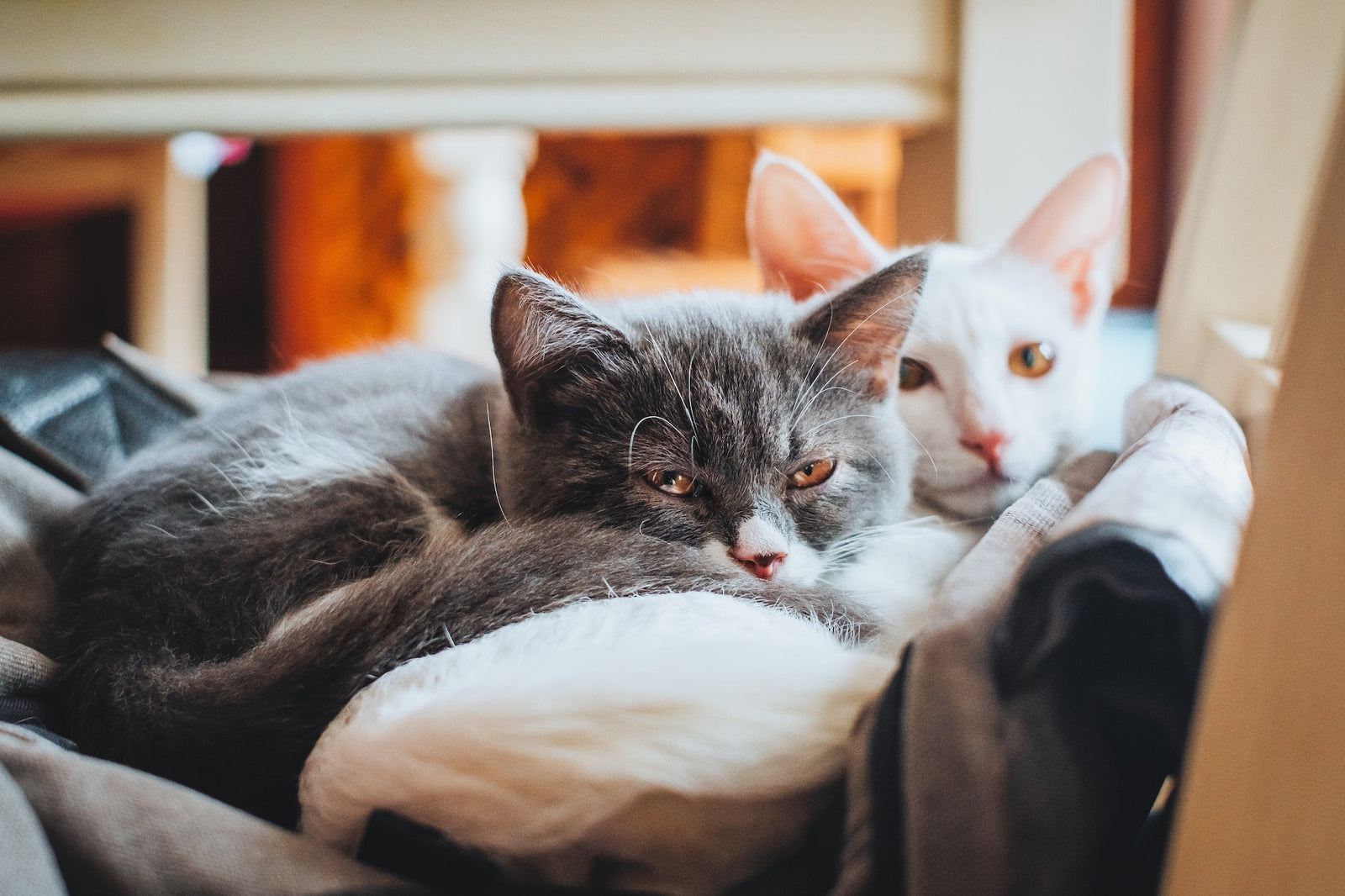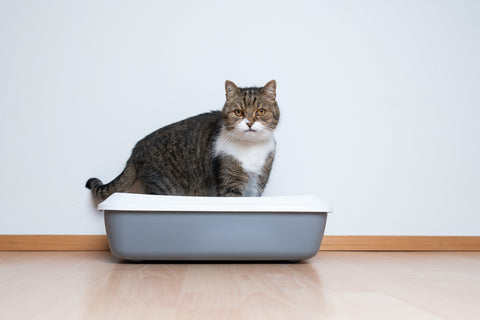
From their furrowed brows to their wise eyes, there’s plenty to love about cats in their double-digits. Older cats make great companions and can be the perfect addition to any family of feline fanatics. If you’re taking in a senior feline for the first time, you may have a number of questions regarding diet, behavior, and, of course, bathroom habits.
Yes, you can train your senior cat to use a litter box, it just takes time, perseverance, and a few helpful tips.
If you’re wondering how to litter train an older cat, this is your purr-fect resource. Read on to learn about litter box placement, tray size, training tricks, and the best litter for your elderly kitty. When learning about caring for an older cat, this is often a great place to start. Remember, accidents might happen, but you can teach an old cat new tricks.
Step 1: Location, Location, Location: Where to Put Your Litter Box(es)
While humans prefer our toilets in the bathroom, older cats are less predictable when it comes to litter box preferences. For outdoor cats, the world is their bathroom, and they’re happy to dig and bury their business, out of sight and out of mind.
If you’re dealing with a mostly outdoor cat and wondering why their cat litter box is always empty-mystery solved. A litter tray might be more of their preference since it is closer to the floor. On the other hand, an indoor cat is going to need a designated place for bathroom business. Cats typically take naturally to litter boxes and are often trained at a young age by their mother. Unfortunately, older cats don’t necessarily have that benefit.
When introducing a senior cat to their new home and new box, there are a few useful tips when deciding on the placement, including:
- Calm and quiet - Cats, especially older cats, are known for their calm demeanors, so they’ll appreciate a stress-free spot to do their business. This means avoiding high traffic areas of your home, where humans might interrupt your cat’s much-needed private time.
- Far from food - It should be obvious that no one likes their bathroom near where they eat, this goes double for cats. Ensure that your older cat’s food and water dishes are relatively far from their litter box, otherwise, they may be less inclined to use either.
- One for each floor - Older cats are a little more accident prone than kittens. To avoid messes, keep a litter box on each level of your home. This way, a litter box is never out of reach and your cat can easily get to one before it’s too late.
- Create a sense of familiarity - Some older cats might need a little extra something to make their litter area feel like their own. Consider bringing their favorite toys, blankets, or other items near their litter box. Don’t put them too close-just near enough that your cat might feel a stronger sense of ownership over their box.
Typically, the more litter boxes the better, but that doesn’t mean you need to crowd your house with kitty bathrooms. If you have multiple cats, it’s recommended to keep one box for each if you don’t want to be cleaning them multiple times a day.
Otherwise, pick a place and try to stick to it. Cats aren’t fans of their boxes frequently moving around, and it could make it even harder to litter train your senior cat. If your cat is having incontinence issues, it’s best to know the signs your cat is getting older to know if it’s perhaps a bigger problem.

Step 2: Pick A Box Your Cat Will Appreciate
Litter boxes come in all shapes and sizes. From covered litter boxes to furniture-shaped enclosures, you can easily select an option that fits your space and your cat.
Yes, senior cats have their own preferences when it comes to litter box types, and if you’re aiming to make your litter box training sessions a little easier, you might consider the following advice when picking out a box:
- Uncovered - While top-entry litter boxes can help avoid messes, they’re often a little too uncomfortable for older cats. Additionally, doors and enclosures can make it more difficult, claustrophobic, or otherwise unpleasant for some senior kitties. A simple, uncovered box ensures the fewest obstacles in between your cat and their litter.
- Give them some space - Treat your kitty to a litter luxury by opting for a larger-sized litter box. Often square or rectangular boxes come in extra-large sizes to allow your cat a little more square footage for comfort and ease.
- Consider a ramp - If your litter box has tall sides, you may want to attach a short incline to make it easier for your senior cat to get in. While most cats retain their abilities to jump and climb well into their golden years, it can still be helpful to offer them some help getting into their box-at least while you’re training them.
When selecting a box for your elderly cat, it’s most important to choose something that will be comfortable for their old bones to step in and out of on a daily basis. If your older cat has health problems, they may have a hard time getting in and out of a traditional litter box. There’s no need for fancy features or intricate designs– sometimes the simplest options are the best. Senior cats might even appreciate something a bitold school.

Step 3: Make A Proper Introduction
Cats need to be shown where they’ll be doing their business. That means more than a simple gesture at the box and a knowing nod to your cat. Older cats frequently deal with deteriorating vision and cognitive abilities, making it all the more difficult for them to know what their litter box is for.
Since you can’t simply tell your cat that this plastic square is their new bathroom, you’ll need to work one-on-one to familiarize your senior cat with their litter box.
Consider the following aspects of introducing your cat to their litter box:
- Encourage them to explore during litter box training - Cats like to sniff, paw, and scratch their way through new experiences. If your senior cat is acting uncertain about their litter, it might be best to simply pick up and place them inside the box. Once inside the box, they can move around, get their bearing, and start to feel out what the box is for.
- Provide positive feedback (at the right time) - Training a cat can be a little tricky, but they still respond well to positive reinforcement. You'll probably encounter a litter box problem here and there but don't get discouraged! After your cat’s initial introduction to their litter box, you can encourage them to return through encouraging pets, treats, and play activities.
- Have some patience - This introduction may take some time. If your cat doesn’t begin using their box when you first put them near it, don’t get too hard on yourself (or your cat). Felines do things on their own time, and that can mean waiting a few hours or even days for them to take the first steps toward using their litter box.
Be warned, first introductions especially for an adult cat can be a little messy. Don’t be surprised if your cat starts throwing litter, creating a dusty perimeter. As well, some litter may be stuck to their paws, creating little kitty prints from the box all the way to their favorite spot to sleep. Consider a low-dust litter option to keep your house a little cleaner.
Step 4: Focus on Cleanliness and Litter Preferences
Cats like things clean, from their pristine coats to their pearly white claws. The same goes for their litter box. Older cats can be easily put off from using a litter box if it appears too dirty. This can make training especially difficult if they’re sharing with other cats.
Cleanliness should be a top priority during the training process and after. To keep your senior cat’s bathroom habits consistent and build a healthy routine, try to follow the following cleaning protocols:
- Frequent scooping - For a single cat, a litter box should be scooped at a minimum every other day. This will keep the box from ever getting too dirty for your senior cat to comfortably do their business. With multiple cats (or for those who prefer things extra clean) a daily scooping session might be the best option.
- Monthly clean out - No matter how frequently you scoop, you’ll still need to clean out the entire litter box on a regular basis. That means emptying the box of all litter and using non-toxic cleaning products to decontaminate the plastic surfaces. After that, you can refill with fresh litter (give scented litter a try!) and let your cats enjoy their sparkling clean commode. Once or twice a month is adequate for most cats.
- Hold back on cleaning at first - Despite the previously mentioned litter sanitation advice, you should avoid cleaning your new cat’s litter too soon after they’ve first used it. Cats know their bathroom spots based on familiar smells, so by leaving their waste alone (at least at first), they’ll have a clear idea of where to return to when nature calls. Clumping litter makes it easier to hold out on cleaning.
In addition, you can experiment with how much litter you put inside your litter boxes. Or, read up on how much cat litter to use. Some cats prefer a box nearly full with litter while others are more comfortable with a thinner layer, so expect a bit of trial and error.
Train Your Elderly Cat with Pretty Litter
With a firm grasp on older cats’ bathroom preferences and plenty of tips to try, all you’ll need is a little patience. Before you know it, you're going to be an expert in litter box training. After a couple of weeks of consistent usage, you can be confident that your senior cat is properly litter trained. Of course, there’s one last factor to consider-what litter to use?
It’s time to try Pretty Litter, the odor trapping, household-friendly, 99% dust-free litter option that’s perfect for aging felines. Our color-changing indication system can help you get ahead of potential problems by giving you a daily heads-up of your cat’s health. At Pretty Litter, we’re about way more than quality litter. We’re about helping pets lead longer, happier, and healthier lives.
Sources:
Excited Cats.How to Litter Train an Older Cat: 8 Easy Steps.https://excitedcats.com/how-to-litter-train-an-older-cat/
Is That Your Cat.What Is The Best Litter Box For Elderly Cats?.https://isthatyourcat.com/best-litter-box-for-elderly-cats/
Senior Cat Wellness. How To Litter Train An Older Cat. https://www.seniorcatwellness.com/how-to-litter-train-an-older-cat/


Follow Us